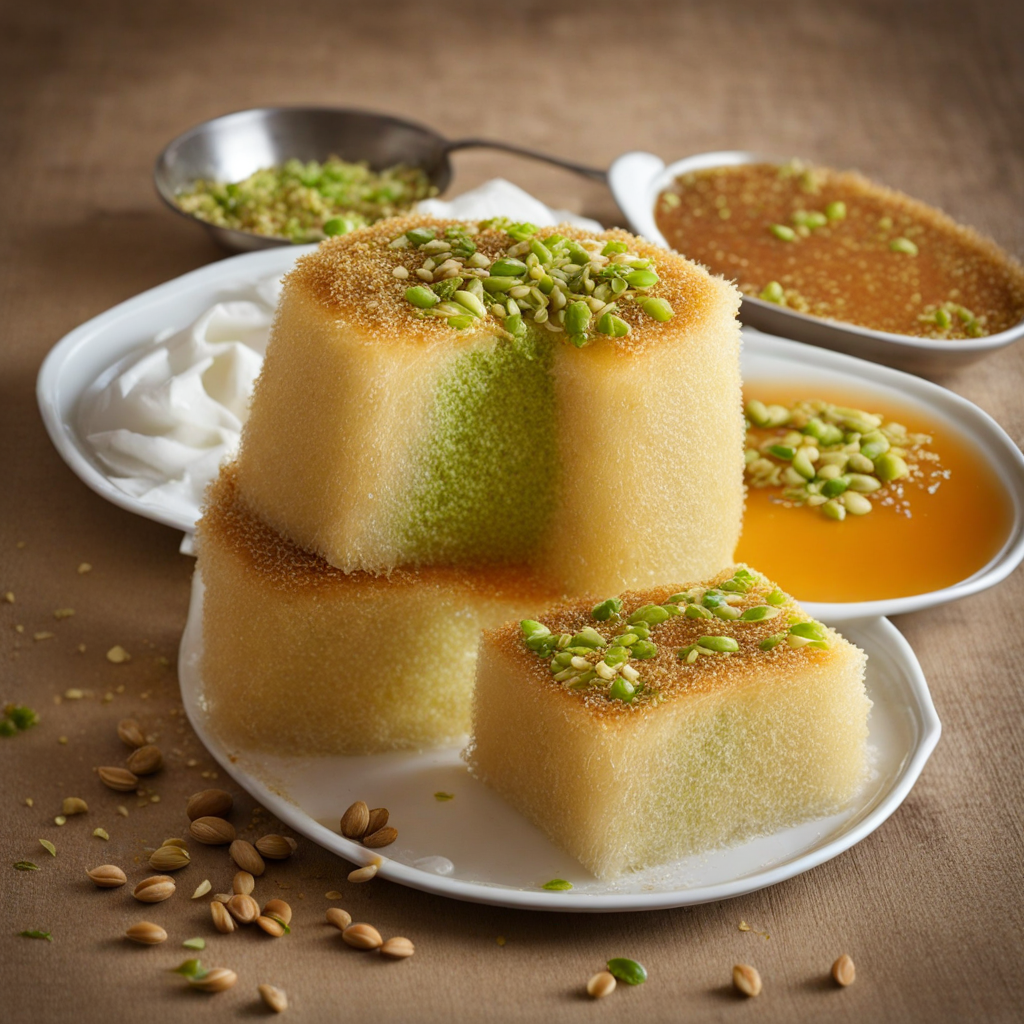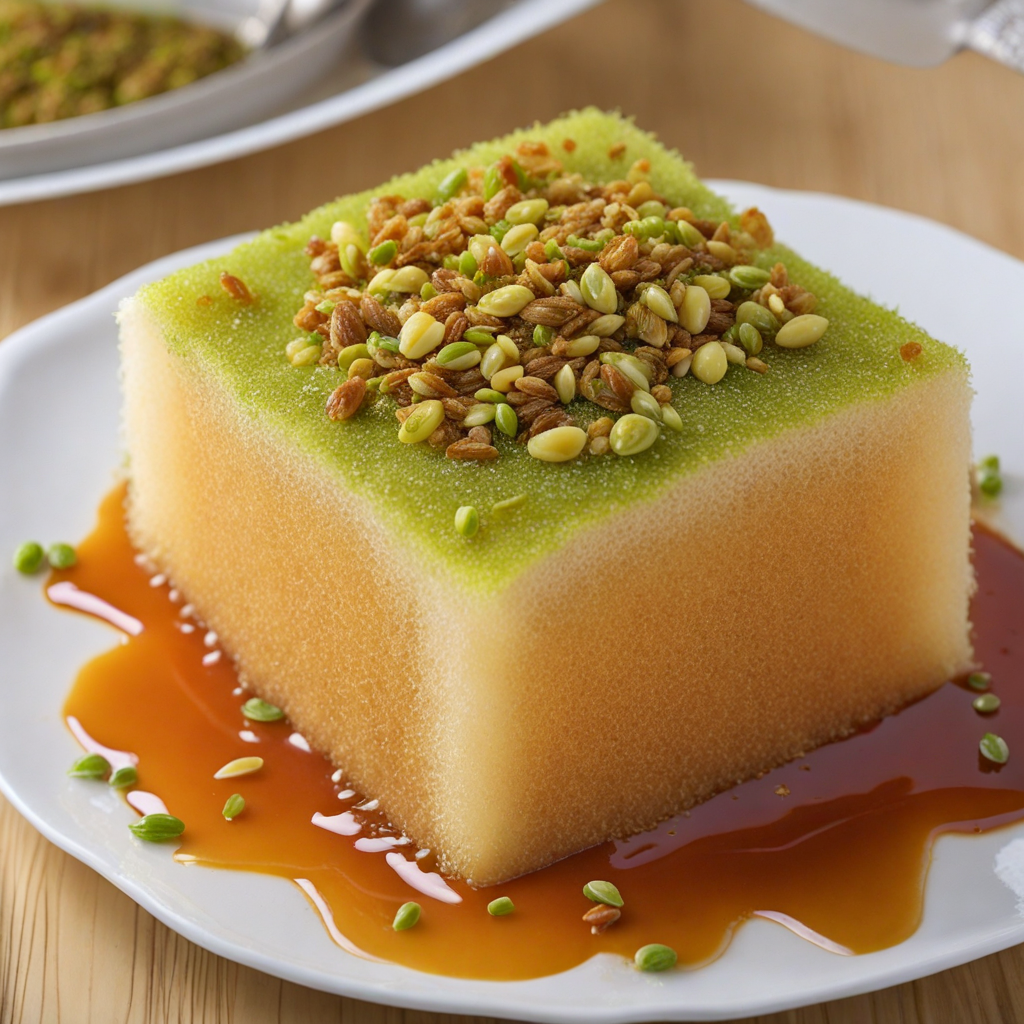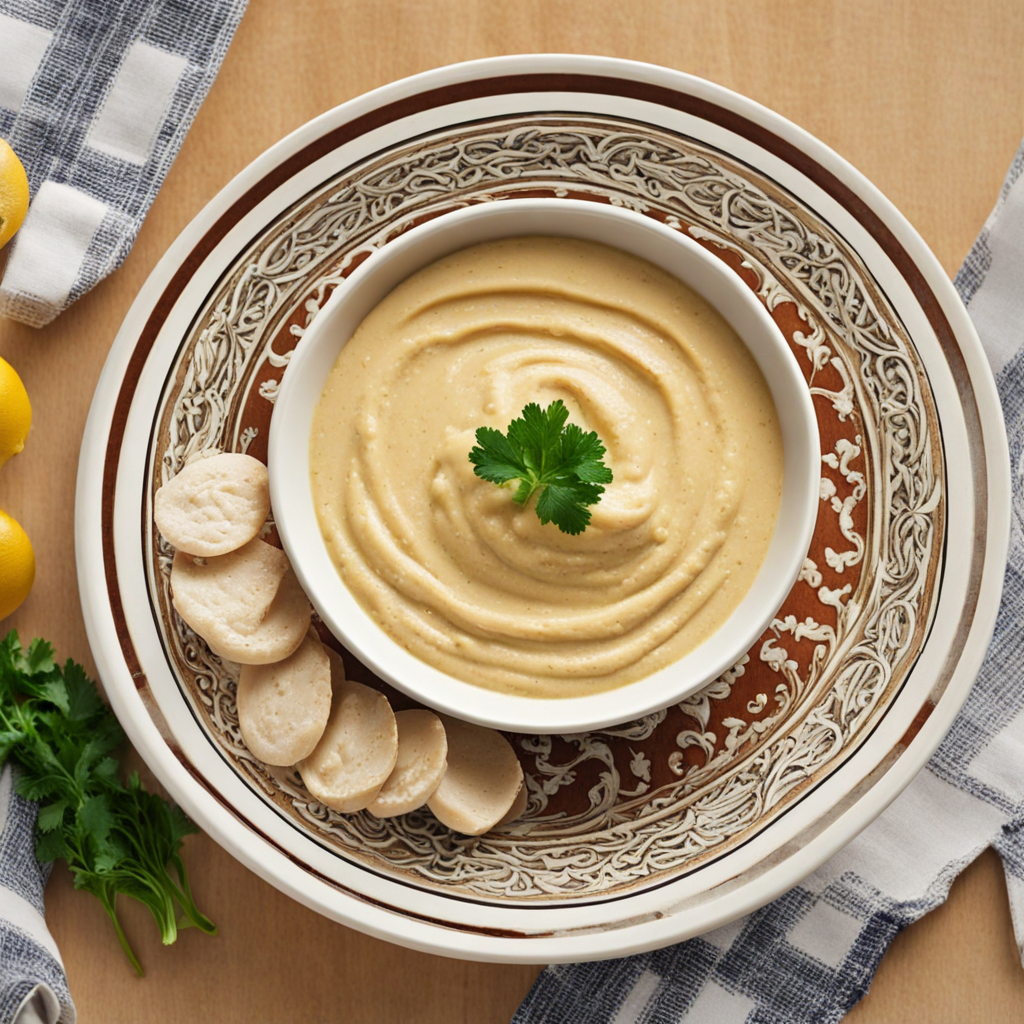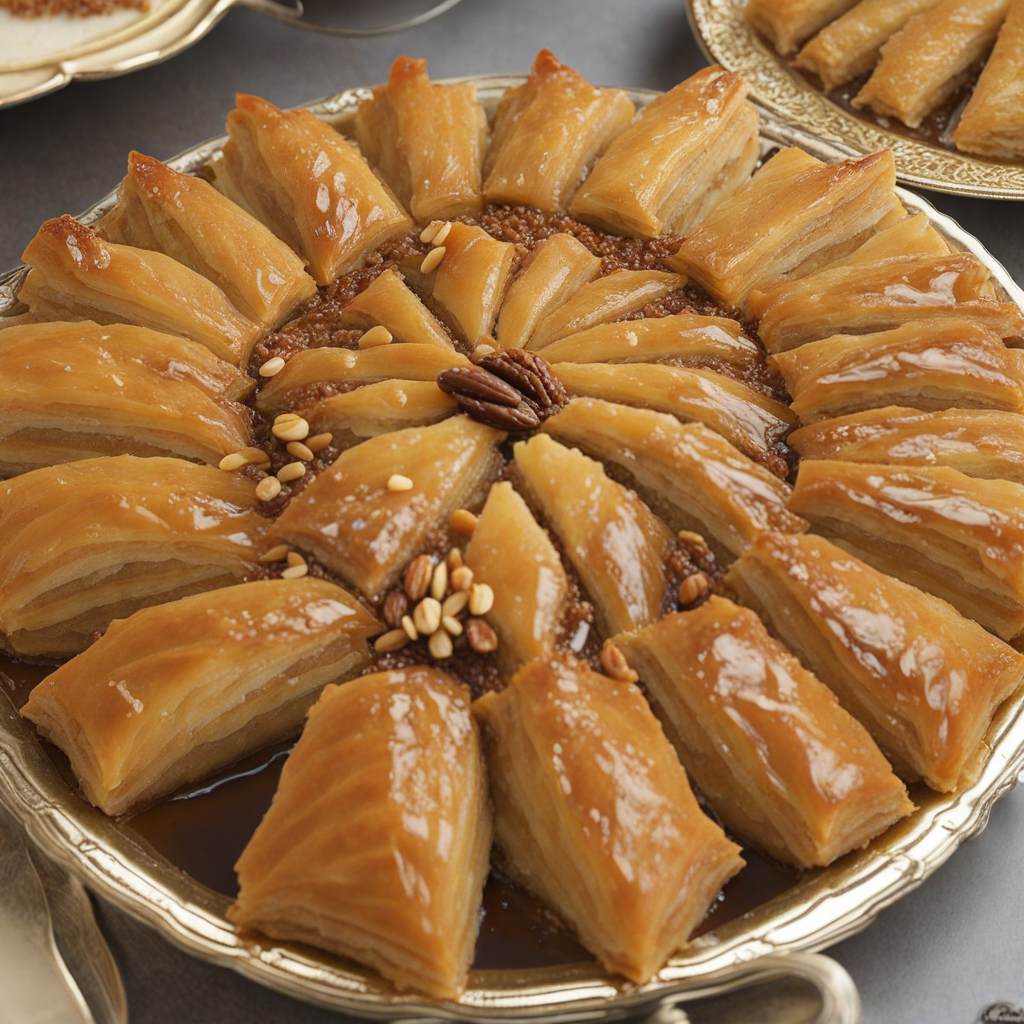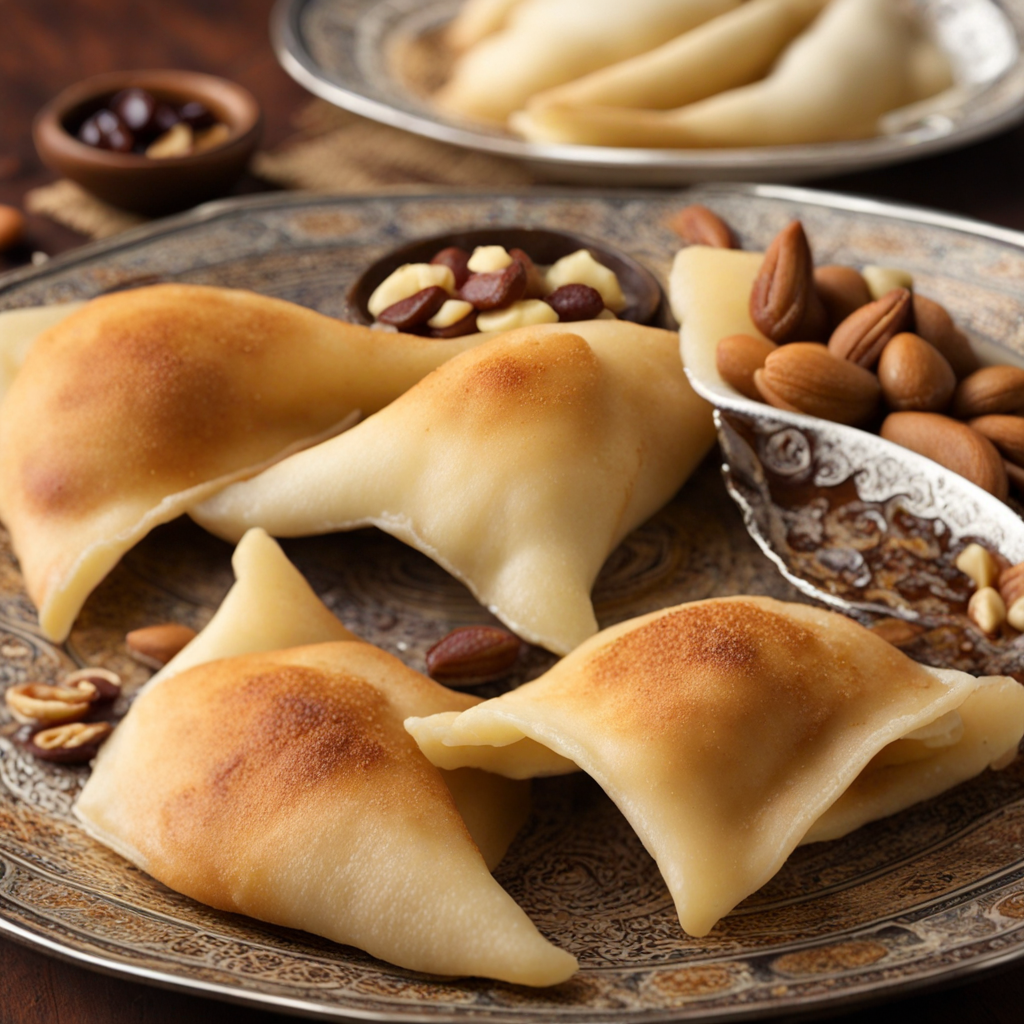Kanafeh
Kanafeh is a traditional Syrian dessert that captivates the senses with its unique blend of flavors and textures. At its core, this dish features layers of thin, shredded pastry known as kataifi, which are baked to a perfect golden crisp. The pastry envelops a rich filling, often made from a creamy cheese or a blend of sweetened semolina, creating a delightful contrast between the crunchy exterior and the luscious interior. The dish is typically soaked in a fragrant syrup made from sugar, water, and a hint of rose or orange blossom water, infusing it with a delicate floral aroma that enhances the overall experience. The preparation of kanafeh is an art in itself, requiring skillful hands to achieve the ideal balance of crispiness and moisture. Once baked, the kanafeh is often garnished with crushed pistachios or walnuts, adding a vibrant color and a nutty crunch that complements the soft, sweet layers. The syrup is poured over the hot pastry just before serving, allowing it to seep into every crevice, ensuring that each bite is a harmonious blend of sweetness and richness. The result is a dessert that is not only visually stunning but also a delightful indulgence that leaves a lasting impression. Enjoying kanafeh is a communal experience, often shared among family and friends during celebrations or special gatherings. It’s served warm, allowing the cheese to stretch beautifully with each forkful, creating a playful and satisfying texture. As you take a bite, the flavors unfold, with the sweetness of the syrup, the richness of the cheese, and the aromatic notes from the syrup dancing together on your palate. This iconic Syrian dessert is truly a must-try for anyone seeking to explore new culinary delights, promising a taste of tradition and the warm hospitality of Syrian culture.
How It Became This Dish
The Enchanting Journey of كنافة: A Syrian Culinary Tradition In the heart of the Levant, where the ancient and the modern intertwine, lies a dessert that has woven itself into the fabric of Syrian culture: كنافة (Kunafa). This sweet treat, known for its delicate layers, rich flavors, and tantalizing textures, has a history as layered as its ingredients. Its origins, cultural significance, and evolution over time offer a fascinating glimpse into the culinary traditions of the region. Origins of كنافة The exact origins of كنافة remain somewhat murky, shrouded in the mists of time and culinary folklore. However, it is widely believed that كنافة traces its roots back to the Ottoman Empire, which dominated much of the Middle East from the 14th century onward. The dessert is thought to have originated in the city of Nablus, located in present-day Palestine, where it was known for its distinctive Nabulsi cheese filling. As trade routes flourished and cultural exchanges occurred, كنافة spread throughout the Levant, reaching Syria, Lebanon, and beyond. The name "كنافة" itself has Arabic origins, derived from the word "كُنُفَة," which refers to the delicate strands of dough that make up its base. Traditionally, كنافة is made from a type of pastry called "kataifi," which resembles fine vermicelli. This pastry is layered with melted butter, nuts, and sweetened cheese, then baked to golden perfection and soaked in syrup, resulting in a dish that is both rich and indulgent. Cultural Significance In Syria, كنافة transcends mere dessert; it is an emblem of hospitality and celebration. The preparation and consumption of كنافة are often associated with significant cultural and religious events. During Ramadan, for instance, families break their fasts with a sweet treat, and كنافة is a popular choice, symbolizing the joy of the holy month. Its vibrant yellow hue, often achieved with the addition of orange blossom water, represents prosperity and happiness, making it a fitting dish to mark joyous occasions. The preparation of كنافة is often a communal affair. Families gather in the kitchen, passing down recipes and techniques from generation to generation. This act of cooking together fosters bonds and strengthens familial ties, making كنافة not just a dish, but a cherished tradition. In many households, the recipe for كنافة is considered a closely guarded secret, passed down like a family heirloom, signifying its importance in the cultural heritage of the region. The Evolution of كنافة As with many traditional dishes, كنافة has evolved over time, adapting to changing tastes and influences. The classic version, featuring Nabulsi cheese, remains a favorite, but regional variations have emerged, each adding its unique twist. In Syria, one can find كنافة made with a variety of fillings, including pistachios, walnuts, or even chocolate. These adaptations reflect the local ingredients available and the culinary creativity of each region. In the 20th century, the rise of modern culinary techniques and globalization introduced new flavors and presentation styles to كنافة. Chefs began experimenting with fusion cuisine, incorporating international ingredients and techniques. For example, some variations now feature a layer of crème brûlée on top, creating a delightful contrast between the crunchy caramelized sugar and the soft, gooey filling. This innovative approach has attracted a younger generation, eager to explore traditional flavors in contemporary forms. Despite these innovations, traditional كنافة remains a staple in Syrian households and bakeries. The sight of a baker skillfully preparing a large tray of كنافة, the strands of pastry twirling and intertwining, is a common one in bustling marketplaces. Street vendors often sell كنافة fresh from the oven, drizzling it with syrup and garnishing it with crushed pistachios, inviting passersby to indulge in this decadent treat. Notable Variants and Regional Differences While the essence of كنافة remains constant, regional differences offer a delightful array of flavors and textures. In Aleppo, for example, the local variant, known as "كنافة حلب" (Aleppo Kunafa), is particularly renowned for its use of finely shredded dough and a filling of sweetened cheese or cream. The preparation involves a meticulous layering process, and it is often served with a drizzle of rosewater syrup, enhancing its aromatic profile. In Damascus, another version, "كنافة نابلسية," is cherished for its thicker layers and the use of Nabulsi cheese, which provides a distinctive saltiness that balances the sweetness of the syrup. This version is often topped with crushed nuts and served warm, creating a delightful contrast between the crispy exterior and the gooey interior. كنافة in the Modern World As globalization continues to shape culinary landscapes, كنافة has found its way into international cuisine, garnering attention from food enthusiasts and chefs worldwide. The rise of social media has played a pivotal role in this phenomenon, with platforms like Instagram showcasing stunning images of كنافة, inspiring food lovers to try their hand at making it at home or seeking it out in restaurants. In recent years, several culinary festivals and competitions have celebrated كنافة, further elevating its status as a beloved dessert. Chefs experiment with flavors, textures, and presentations, pushing the boundaries of this traditional dish while still honoring its roots. The ongoing dialogue between tradition and innovation ensures that كنافة remains relevant and exciting in the contemporary culinary scene. Conclusion The history of كنافة is a testament to the rich tapestry of Syrian culture and its culinary traditions. From its humble beginnings in the kitchens of the Ottoman Empire to its status as a beloved symbol of celebration and togetherness, كنافة embodies the spirit of hospitality that defines Syrian culture. Its evolution over time reflects not only changes in culinary trends but also the resilience of tradition in the face of modernity. As families continue to gather around the table to share this exquisite dessert, كنافة serves as a reminder of the power of food to connect people, celebrate heritage, and create lasting memories. Whether enjoyed in a bustling bakery or prepared lovingly at home, كنافة will always hold a special place in the hearts—and stomachs—of those who cherish its delightful flavors and the stories it carries.
You may like
Discover local flavors from Syria


